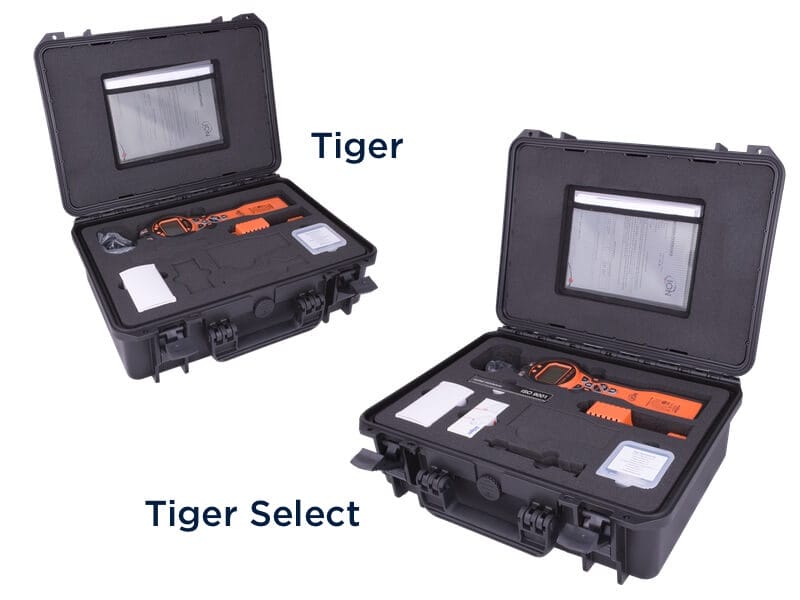
New carry cases for Tiger and Tiger Select portable VOC gas detectors
The Tiger and Tiger Select carry cases have now been redesigned, and new cases will shortly start to be available with Tiger and Tiger Select kits, as standard.
The new cases are now smaller, lighter and more robust, ensuring that the instrument and accessories are fully protected.
The new cases will also be available for the MVI kits in the near future.
Tiger handheld VOC detector
The Tiger is a revolutionary handheld gas detection instrument for the rapid, accurate detection of volatile organic compounds (VOCs) within the harshest of environments.
Tiger incorporates Ion Science patented photoionisation detection (PID) sensor technology with humidity resistance and anti-contamination design, proven to dramatically extend run time in the field.
A robust VOC detector Tiger provides a dynamic detection range of 0 to 20,000 parts per million (ppm) with a minimum sensitivity of 0.001ppm (1 ppb), offering the widest measurement range of any other VOC detector on the market.
This handheld VOC detector has the fastest response time on the market of just two seconds and is just as quick to clear down. The instrument can be connected directly to a PC via the USB offering extremely fast data download capabilities.
Tiger has been designed for the safe replacement of batteries in hazardous environments. Long-life rechargeable Li-ion batteries give up to 24 hours of use. Fast battery charging allows the instrument to be fully charged in 6.5 hours, while 8 hours of use can be achieved from 1.5 hours charge.
Low-cost filters and lamps can be easily changed in seconds, minimising instrument downtime. Inexpensive disposable parts mean the Tiger VOC detector has the lowest running costs on the market.
Tiger is a fully upgradeable VOC detector with multiple functions to choose from. A base unit can be upgraded with data logging, health and safety and ppb options, remotely, without needing to be returned to the factory.
Tiger offers simple, one-handed operation for easy VOC detection. Its rugged design and protective, removable rubber boot withstand the harshest environments.
The large, clear back-lit display allows for easy viewing in any light condition. An integrated torch is designed for directing the instrument’s probe into dimly lit areas.
Ready to use on start-up the Tiger VOC detector needs no complex set up procedures via a PC to perform basic functions. Its simple-to-use software features require minimal user training.
Tiger uses the same PID sensor technology found within all Ion Science handheld, personal and fixed VOC detectors. This ground-breaking PID technology is widely used and trusted by major gas detection manufacturers worldwide.
Tiger Select handheld benzene detector
The Tiger Select is a revolutionary hand-held gas detector for the rapid, accurate detection of benzene and Total Aromatic Compounds(TACs).
Utilising the high output Ion Science 10.0 eV detection system, a reading for TACs is seen immediately on start-up. Should aromatics be detected, an ION Science benzene pre-filter tube can be easily attached to ensure fast detection and selective measurement of benzene.
Throughout the measurement process, Tiger Select continues to display real-time data, ensuring the final reading represents the full value of actual benzene present. Benzene concentrations are displayed down to parts-per-billion (ppb) levels, giving you accurate, reliable data you can count on.
Tiger Select is capable of providing 15-minute short-term exposure limits (STELs) and 8-hour time-weighted averages (TWAs) for total aromatic compounds (TACs). A 10.6 eV lamp can easily be installed for the detection of a wide range of VOCs.
In addition, the unique Ion Science PID sensor incorporates both humidity resistant technology and anti-contamination design for extended operation in difficult working environments.
The Tiger Select benzene and total aromatic compound detector can also be used in standard Tiger operational mode without the use of a benzene pre-filter tube to deliver active indications of volatile organic compounds (VOCs), including benzene, at concentrations as low as 1 ppb benzene equivalent.











